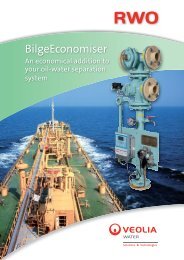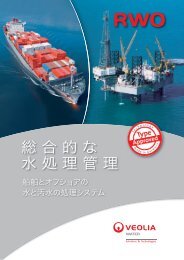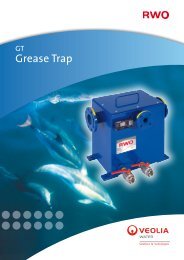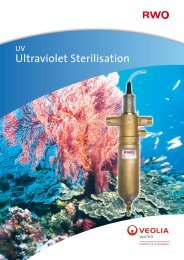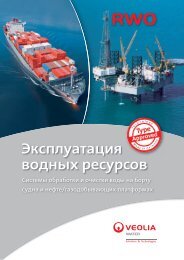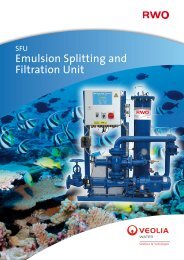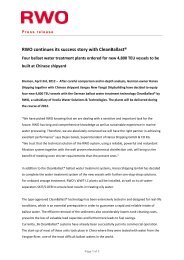the IHS Ballast Water Guide - RWO Marine Water Technology
the IHS Ballast Water Guide - RWO Marine Water Technology
the IHS Ballast Water Guide - RWO Marine Water Technology
Create successful ePaper yourself
Turn your PDF publications into a flip-book with our unique Google optimized e-Paper software.
Sponsored by <strong>IHS</strong> Fairplay Solutions <strong>Guide</strong> to <strong>Ballast</strong> <strong>Water</strong> Treatment Systems<br />
Aquastar<br />
Aqua Engineering 2 7<br />
This BWM system has been developed by<br />
Aqua Engineering of Busan, South Korea and<br />
has been granted basic approval for <strong>the</strong> active<br />
substance used in treatment.<br />
The process involves <strong>the</strong> use of a so-called<br />
‘smart’ pipe and treatment with <strong>the</strong> active<br />
substance sodium hypochlorite formed by in<br />
situ electrolysis of <strong>the</strong> seawater in a ballast<br />
water main pipe.<br />
The compact smart pipe can be installed as<br />
<strong>the</strong> main section of <strong>the</strong> ballast pipe, which<br />
requires <strong>the</strong> minimum of space.<br />
The AquaStar system consists of an in-line<br />
electrolyser unit, <strong>the</strong> modules of which can<br />
be installed horizontally or vertically. The<br />
electrolyser is controlled from an integrated<br />
automatic control system unit, which has a<br />
master and local control unit and incorporates<br />
<strong>the</strong> ballast pump.<br />
Total residual oxidants are neutralised by<br />
controlled injection of sodium thiosulphate<br />
from a neutralisation unit during deballasting.<br />
A rectifier unit and gas separator with vent is<br />
used during <strong>the</strong> treatment process.<br />
The AquaStar system requires <strong>the</strong> safe<br />
storage of <strong>the</strong> neutralising agent sodium<br />
thiosulphate on board ship in a tank. The risk<br />
associated with <strong>the</strong> generation of hydrogen<br />
gas during electrolysis is being taken into<br />
consideration during testing.<br />
The system is marketed in a range of<br />
models, from <strong>the</strong> smaller systems suited to<br />
chemical tankers, bulkers and box ships, with<br />
ballast pumps rated from 350 to 1,100m 3 /h<br />
at a total required power of up to 88kW/h,<br />
to slightly bigger systems for Panamaxes<br />
and Capesizes, to <strong>the</strong> biggest models with<br />
pumps that handle 5,000m 3 /h at a power<br />
requirement of 300–400kW/h.<br />
Anolyte<br />
Atlas-Danmark 2 7<br />
The ballast water treatment system<br />
from Atlas-Danmark is named after <strong>the</strong><br />
disinfecting agent, which is a biocide<br />
mixture. It also uses filtration, and a reducing<br />
agent, known as Catolyte.<br />
Its maker describes <strong>the</strong> Anolyte<br />
disinfection agent applied in <strong>the</strong> system as<br />
“electrochemical activated water”, which<br />
contains a mixture of reactive molecules<br />
and meta-stable ions and free radicals. The<br />
company says <strong>the</strong> disinfection agent destroys<br />
itself during <strong>the</strong> disinfection process, <strong>the</strong>reby<br />
ensuring that <strong>the</strong> environment and <strong>the</strong> crew<br />
are not endangered.<br />
The Anolyte is taken from available tanks<br />
or those built into <strong>the</strong> vessel for <strong>the</strong> storage<br />
during <strong>the</strong> period for production of <strong>the</strong><br />
disinfection agent. It is injected into <strong>the</strong><br />
BWTS by a dosing pump that can be located<br />
anywhere between <strong>the</strong> Anolyte storage tank<br />
and <strong>the</strong> ballast water intake connection.<br />
The electrolytic cells used in <strong>the</strong> ballast<br />
water treatment system act as <strong>the</strong> Catolyte<br />
reducing agent. During <strong>the</strong> process, <strong>the</strong><br />
Catolyte is fed directly to one or more of <strong>the</strong><br />
ballast tanks. After <strong>the</strong> Anolyte disinfection,<br />
<strong>the</strong> Catolyte is said to slightly increase <strong>the</strong> pH<br />
value and corrosion resistance in <strong>the</strong> ballast<br />
water tanks.<br />
The ozone and <strong>the</strong> o<strong>the</strong>r compounds in <strong>the</strong><br />
Anolyte are injected during natural flow of<br />
<strong>the</strong> ballast pumps and filters. When added to<br />
<strong>the</strong> filtered ballast water during <strong>the</strong> intake, all<br />
micro-organisms are reportedly killed within<br />
a few seconds.<br />
By using a self-cleaning, pre-filtration<br />
filter of less than 50µm, <strong>the</strong> Anolyte portion<br />
is reported to be substantially reduced,<br />
depending on <strong>the</strong> filter size.<br />
© <strong>IHS</strong> Global Limited 2012 13<br />
012_037_CorrectedBW1204.indd 13 01/08/2012 15:30:03



